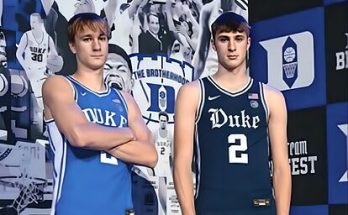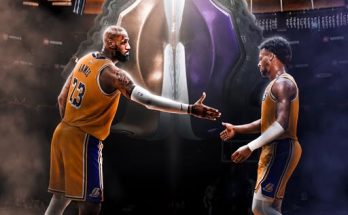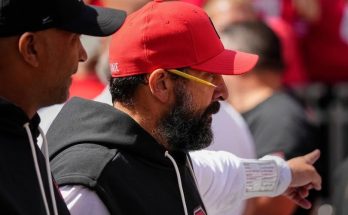Harry Douglas’s Stark Assessment: Can the Philadelphia 76ers Truly Be Repaired?
The world of professional basketball is a constant whirl of ambition, expectation, and often, profound disappointment. For the Philadelphia 76ers, a franchise steeped in history and often burdened by the weight of its own strategic decisions, the sentiment of late has leaned heavily towards the latter. Amidst the swirling speculation and fervent debate that characterizes NBA discourse, a particularly blunt assessment from analyst Harry Douglas recently cut through the noise, resonating deeply with a fanbase desperate for answers but increasingly resigned to a grim reality. “I do not believe this can be repaired, I really don’t,” Douglas declared on ESPN’s “First Take,” a statement that has since echoed through the corridors of sports media, igniting conversations about the fundamental viability of the Sixers’ current path. This isn’t merely a throwaway line; it’s a profound indictment, suggesting that the team’s issues run deeper than simple tactical adjustments or a change of personnel – they might be structural, systemic, and perhaps, irreversible.
To understand the weight of Douglas’s words, one must first appreciate the convoluted journey of the Philadelphia 76ers, particularly over the last decade. The “Process,” a controversial but ultimately captivating strategy, was designed to bottom out the franchise, accumulate elite draft picks, and build a sustainable contender around generational talent. Joel Embiid, the towering Cameroonian center, emerged as the undeniable cornerstone of this vision, a player whose blend of skill, physicality, and personality promised to redefine the modern big man. Alongside him, the team sought to assemble a complementary cast, a mission that has been fraught with both dazzling highs and crushing lows.
Embiid’s tenure in Philadelphia has been a microcosm of the team’s broader narrative: brilliant, dominant, yet perpetually shadowed by questions of health and ultimate playoff success. He has achieved MVP status, showcasing an offensive repertoire rarely seen in a player of his size, coupled with formidable defensive prowess. Yet, the narrative of his career, and by extension, the Sixers’ aspirations, remains incomplete. Time and again, deep playoff runs have been derailed by injuries – to Embiid himself, or to key teammates at critical junctures – or by an inability to consistently overcome mental or strategic hurdles in high-stakes environments. As insider Bobby Marks recently underscored on “NBA Today,” this offseason marks a critical juncture for the Sixers if they hope to retain Embiid long-term, noting the looming “danger zone” of his contract in its final year. Marks, like Douglas, hints at a sense of urgency, if not desperation, surrounding the franchise’s need to “make this work.” Embiid’s track record of playing in just 58 total regular-season games over the past two seasons, despite his scoring dominance, has fueled the skepticism regarding the team’s ability to rely on him for a full, grueling playoff push. The painful truth is that despite his individual brilliance, Embiid has yet to lead the Sixers past the second round of the playoffs, a consistent barrier that has contributed to the growing despair.
The latest significant attempt to “repair” the team and elevate it to championship contention was the high-profile acquisition of Paul George. The addition of a multi-faceted two-way star like George was hailed as a potential game-changer, forming a new “big three” alongside Embiid and the burgeoning Tyrese Maxey. The vision was clear: to combine Embiid’s interior dominance with George’s perimeter scoring and defense, and Maxey’s explosive offensive talent. On paper, it presented a formidable challenge to any opponent. However, the reality has been far less harmonious. As an article from Sports Illustrated highlighted recently, the most obvious problem for Philadelphia has been the simple fact that its new star trio has yet to consistently share the floor. George, like Embiid, has battled knee problems, missing crucial games early in the season. Maxey too has had hamstring issues, contributing to a start to the season that was, by any measure, disastrous.
This inability of the star players to stay healthy and coalesce on the court has been a recurring nightmare for the Sixers. The inherent risk of building a team around two historically injury-prone superstars like Embiid and George has unfortunately materialized, and the consequences have been severe. Beyond the mere absence of their star power, the article pointed out a more troubling trend: Embiid and George haven’t played like superstars even when healthy. This dual blow – injuries compounded by underperformance – has been particularly galling given the lofty expectations. The team’s offensive struggles earlier in the season, ranking dead last in points per game and near the bottom in field goal and three-point percentage, further underscored the depth of their problems. Their point differential was among the worst in the league, and even their defense, while not terrible, was allowing a high opponent field goal percentage. This wasn’t a case of bad luck or a few close losses; the statistics painted a stark picture of a fundamentally flawed team.
Harry Douglas’s pronouncement on “First Take” – “Either Joel Embiid needs to go somewhere else or Daryl Morey needs to go somewhere else. I do not believe this thing can be repaired, I really don’t” – encapsulates the frustration and the sense of an impasse within the organization. This isn’t just about personnel on the court; it points to a deeper issue of strategic direction and organizational cohesion. The implication is that the current combination of star players, coaching staff, and front office decisions has led to a stagnant, perhaps even regressive, state from which recovery appears unlikely without a drastic shake-up.
The constant cycle of injuries, the consistent playoff disappointments, and the perpetual search for the “right” complementary pieces around Embiid have created a brutal repeating pattern. Fans and analysts alike are questioning whether the current core, regardless of individual talent, can ever truly overcome these persistent hurdles to achieve championship glory. The idea of “repair” suggests mending something broken, fixing existing flaws. But if the very foundation is crumbling, or if the cracks are too deep and pervasive, then “repair” becomes an insufficient term; what’s needed is a complete overhaul.
Daryl Morey, the Sixers’ President of Basketball Operations, has been a central figure in shaping the current roster. His aggressive, analytically-driven approach has led to significant roster turnovers, including the departure of key players like Tobias Harris, Nicolas Batum, De’Anthony Melton, and Paul Reed. While some of these moves were made to acquire Paul George and create cap space for other additions, the constant churn can impact team chemistry and continuity. The recent free agency signings, such as Dominick Barlow, Trendon Watford, and Jabari Walker, along with draft picks like Johni Broome, suggest an ongoing effort to address weaknesses, particularly rebounding, which was identified as a significant issue. However, whether these additions are enough to fundamentally shift the team’s trajectory remains a major question mark, especially given the larger issues at play.
The sentiment of “no fixing” or “irreparable” isn’t unique to Harry Douglas. It reflects a growing fatigue among those who follow the NBA. When a team consistently underperforms relative to its talent, when its star players are perpetually sidelined, and when its strategic vision seems to hit the same walls repeatedly, the hope for simple repairs begins to fade. It transforms into a belief that the very fabric of the team, or the fundamental approach to its construction, is flawed beyond conventional remedies.
What would “repair” even look like for the 76ers? It would necessitate a sustained period of health for Embiid and George, allowing them to build chemistry with Maxey and the rest of the roster. It would require the new additions to not only fit schematically but also to elevate the team’s overall performance, particularly in areas like rebounding and consistent perimeter shooting. It would demand the coaching staff, led by Nick Nurse, to find a system that maximizes the talents of all players and adapts effectively to the inevitable challenges of an NBA season. Crucially, it would involve the stars consistently performing at an elite level, not just individually, but in a way that translates to deep playoff success.
However, the tangible news suggests that this ideal scenario remains elusive. Gilbert Arenas, another prominent voice in basketball media, has also expressed concerns, stating that the Philadelphia 76ers are “set up to fail (again).” His analysis points to the front office’s failure to acquire “insurance” for Embiid through the draft, highlighting a broader criticism of roster construction that leaves the team vulnerable to the very issues that plague it.
The current state of the 76ers is a complex tapestry woven with threads of immense talent, frustrating injuries, strategic gambles, and perennial playoff shortfalls. Harry Douglas’s “I do not believe this can be repaired” isn’t a casual dismissal; it’s a diagnosis born from observing a pattern of unfulfilled potential and persistent obstacles. It forces a challenging question upon the franchise and its loyal fanbase: If it truly cannot be repaired, what then? Does it mean a painful dismantling and another arduous “Process”? Or is there an as-yet-unseen path to redemption that will defy the current pessimism? The answers, unfortunately, are unlikely to be simple, and for a franchise that has promised so much, the road ahead appears as uncertain and perilous as ever.
The ongoing struggles of the 76ers, as highlighted by Douglas, are not merely about a few bad games or a losing streak. They represent a culmination of issues that have plagued the franchise for years. The reliance on one dominant, yet often injured, player in Joel Embiid has proven to be a double-edged sword. While his presence elevates the team to elite status when healthy, his absences consistently derail momentum and expose underlying roster deficiencies. The supporting cast, despite numerous alterations and investments, has often failed to consistently step up in Embiid’s absence or provide the necessary two-way impact to truly contend.
Moreover, the financial commitments to stars, particularly the recent deal for Paul George, amplify the stakes. When two highly paid, often injured superstars form the core, the margin for error becomes incredibly thin. Every missed game, every setback, weighs heavily on the team’s ability to develop chemistry, establish rhythm, and build the necessary cohesion for a deep playoff run. The notion of the “danger zone” for Embiid’s contract, as mentioned by Bobby Marks, underscores the pressure on the front office. The team is running out of time and flexibility to make this iteration of the 76ers a championship-caliber squad. If they fail to advance further in the playoffs, the question of whether to keep Embiid, a player who embodies both the promise and the frustration of the Process, will become even more pressing.
The cultural impact of Douglas’s statement should not be underestimated. Sports analysts, particularly those with a platform like “First Take,” often articulate sentiments bubbling beneath the surface among fans. The Philadelphia fanbase is known for its passionate, often demanding, nature. They have endured years of rebuilding, invested emotionally in the “Process,” and have consistently shown up in support of the team. To hear a prominent voice declare their beloved team “irreparable” hits a raw nerve. It validates the nagging doubts that many fans harbor – that perhaps, despite all the talent and all the effort, this current configuration is simply not destined for the ultimate prize.
The strategic decisions made by Daryl Morey and the front office are under intense scrutiny. The constant search for the right pieces around Embiid, while understandable, has resulted in a revolving door of teammates. This lack of continuity can hinder the development of on-court synergy and off-court relationships, both crucial for a championship contender. While the recent free agency signings aim to address specific needs, the broader question remains: are these incremental improvements sufficient to fix what Douglas perceives as a fundamentally broken system?
The concept of “repair” in sports often implies a straightforward solution: trade for a missing piece, fire a coach, or wait for injuries to heal. However, what Douglas is implying is something far more complex. It’s the idea that the problems are so deeply ingrained – perhaps in the health of the star players, the cumulative effect of past decisions, or even the psychological weight of repeated failures – that a simple fix is no longer possible. It suggests a fundamental incompatibility between the aspirations of the franchise and the reality of its current composition.
Consider the historical context: the “Process” was designed to create a sustained period of contention. While it yielded an MVP and perennial playoff appearances, the ultimate goal of a championship remains elusive. The current challenges risk turning what was once a bold, forward-thinking strategy into a cautionary tale of what happens when potential doesn’t translate into tangible success. The repeated early playoff exits, particularly the inability to get past the second round, create a psychological barrier that can be just as formidable as any opponent on the court.
Looking ahead, the options for the 76ers, if Douglas’s assessment holds true, are stark. If the current core truly cannot be repaired, then the path forward might involve a more dramatic restructuring. This could mean trading a disgruntled star, undertaking another significant rebuild, or fundamentally changing the organizational philosophy. None of these options are easy, and all carry significant risks. The challenge for the Sixers’ leadership is to determine if the current foundation, however shaky, can still be salvaged, or if a more radical approach is necessary to break the cycle of disappointment.
In conclusion, Harry Douglas’s blunt assertion that the Philadelphia 76ers are beyond repair is not just a sensational soundbite; it’s a reflection of the profound frustration and skepticism that has permeated discussions around the team. It’s an acknowledgment of the persistent injuries, the unfulfilled potential, and the continuous struggle to advance beyond the second round of the playoffs. Whether this assessment proves to be prophetic or merely a moment of profound pessimism remains to be seen. But for now, the question of the 76ers’ repairability hangs heavy in the air, a critical challenge that will define the immediate future of one of the NBA’s most scrutinized franchises. The tangible news, from injury reports to insider comments on star player futures and team performance statistics, paints a picture that lends significant credence to Douglas’s sobering outlook, leaving fans and analysts alike wondering if the Sixers are indeed stuck in a cycle they cannot escape without drastic measures.



